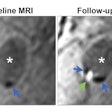Case Western Reserve University in Cleveland and Siemens Healthineers have announced an exclusive research partnership in quantitative MRI.
Siemens and Case Western plan to further develop a method known as "MR fingerprinting," the goal of which is to identify and characterize individual tissues and diseases in a noninvasive way that is independent of the user and scanner. The technique does not acquire traditional clinical images, but instead gathers tissue information based on the signal evolution from each voxel.
Acquisition parameters are varied in a pseudorandom fashion, while the signal evolutions are recorded. The signal evolutions are then compared with a database, or "dictionary," to find the entry that best represents the acquired signal evolution of each voxel.
The dictionary is equivalent to a fingerprint database used in forensics, where all known fingerprints are stored together with all of the information relative to each person. In the case of forensics, each fingerprint points to the feature identification of the associated person, such as name, height, weight, eye color, or date of birth. In the case of MR fingerprinting, each fingerprint in the dictionary points to the MR-related identification features of the associated tissue, such as T1, T2, relative spin density, or diffusion.
The Case Western research team has successfully performed initial tests with brain and prostate tumor patients as well as breast cancer patients with liver metastases. MR fingerprinting has also been used in cardiac examinations and in patients with multiple sclerosis.
Siemens would like to improve the reproducibility of the technique and possibly extend it to different MR scanners and field strengths.
MR fingerprinting is currently under development and not for sale in the U.S. and other countries. Also, its future availability cannot be guaranteed, Siemens said.



.fFmgij6Hin.png?auto=compress%2Cformat&fit=crop&h=100&q=70&w=100)




.fFmgij6Hin.png?auto=compress%2Cformat&fit=crop&h=167&q=70&w=250)











